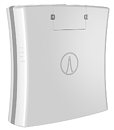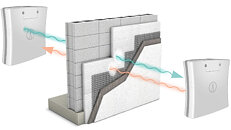TheLostSwede
News Editor
- Joined
- Nov 11, 2004
- Messages
- 18,484 (2.47/day)
- Location
- Sweden
| System Name | Overlord Mk MLI |
|---|---|
| Processor | AMD Ryzen 7 7800X3D |
| Motherboard | Gigabyte X670E Aorus Master |
| Cooling | Noctua NH-D15 SE with offsets |
| Memory | 32GB Team T-Create Expert DDR5 6000 MHz @ CL30-34-34-68 |
| Video Card(s) | Gainward GeForce RTX 4080 Phantom GS |
| Storage | 1TB Solidigm P44 Pro, 2 TB Corsair MP600 Pro, 2TB Kingston KC3000 |
| Display(s) | Acer XV272K LVbmiipruzx 4K@160Hz |
| Case | Fractal Design Torrent Compact |
| Audio Device(s) | Corsair Virtuoso SE |
| Power Supply | be quiet! Pure Power 12 M 850 W |
| Mouse | Logitech G502 Lightspeed |
| Keyboard | Corsair K70 Max |
| Software | Windows 10 Pro |
| Benchmark Scores | https://valid.x86.fr/yfsd9w |
Airvine, the first company to develop a multi-Gigabit-speed wireless backhaul system for indoor connectivity, today announced the general availability of its WaveCore product line. Designed to eliminate the expensive and time-consuming drilling required when confronting concrete barriers (which includes labor, permitting and inspections) to link areas with Ethernet cabling, the WaveCore system consists of a simple point to point bridge with two nodes, measuring 10.1" x 2.7" x 10.3", that are installed one on each side of a concrete wall or floor / ceiling.
The WaveCore is a PTP (point-to-point) layer 2 Ethernet bridge that operates on PoE (power over Ethernet) or a 12 V DC input. Testing with select customers earlier this year has shown results such as a 3 Gbps connection through 8" of concrete in the middle of a 54-foot link and a 4 Gbps connection through a 12" concrete wall in a garage that was in the middle of a 6-foot link.


Concrete walls average 20 cm / 8 in. or more in Commercial Real Estate (CRE) buildings around the world. These types of walls can form a building's perimeter, serve as interior load bearing walls and as protection for spaces such as fire control or network server rooms. Connecting rooms or production areas separated by such walls can be even more problematic than connecting scores of Wi-Fi APs and other equipment in a wide open and spacious factory floor, as it often involves drilling a hole averaging 6" in diameter through the wall, which is known as "core" drilling.
Furthermore, almost all floors in CRE structures are made up of concrete and rebar with a thickness of 4 to 5 inches minimum. To connect the floors, current practice consists of either routing cables to the nearest elevator riser shaft or existing riser or drilling through the floor.
In addition the WaveCore will prove useful in meeting connectivity requirements for fire control rooms. Such rooms are often located in the basement and surrounded by thick concrete walls. These rooms are mandated to have connectivity to the outside world (to the fire department and perhaps other first responder entities) and today typically use 3G connections. Unfortunately for building owners, 3G is now being phased out and 5G does not have the signal propagation to penetrate concrete walls and/or ceilings. Instead of core drilling to connect the outside world to the fire control system with a cable, a WaveCore link can deliver this connectivity cheaper and faster.
"We have proven with customers for more than a year now that the WaveTunnel provides cost-effective Gigabit-speed connectivity in MDUs, factories, warehouses, conference centers and other similarly large properties," said Vivek Ragavan, CEO of Airvine. "However, we could not achieve the company's founding vision of providing pervasive indoor wireless connectivity because we literally kept running into concrete barriers. The WaveCore system surmounts these obstacles and enables us to connect wirelessly any building with any floor plan anywhere."
The combined WaveTunnel and WaveCore solution is managed by the VineSuite software platform, which facilitates network set-up and operation.
"We trialed the WaveCore bridge at one of our facilities and we were amazed by the ability of the WaveCore bridge to blow through several inches of concrete with a multi Gbps signal," said JP Plouffe, Regional Vice President of CSI. "We can see where the WaveCore would save us considerable time and money when we need to connect adjacent rooms or areas separated by such a barrier."
View at TechPowerUp Main Site | Source
The WaveCore is a PTP (point-to-point) layer 2 Ethernet bridge that operates on PoE (power over Ethernet) or a 12 V DC input. Testing with select customers earlier this year has shown results such as a 3 Gbps connection through 8" of concrete in the middle of a 54-foot link and a 4 Gbps connection through a 12" concrete wall in a garage that was in the middle of a 6-foot link.


Concrete walls average 20 cm / 8 in. or more in Commercial Real Estate (CRE) buildings around the world. These types of walls can form a building's perimeter, serve as interior load bearing walls and as protection for spaces such as fire control or network server rooms. Connecting rooms or production areas separated by such walls can be even more problematic than connecting scores of Wi-Fi APs and other equipment in a wide open and spacious factory floor, as it often involves drilling a hole averaging 6" in diameter through the wall, which is known as "core" drilling.
Furthermore, almost all floors in CRE structures are made up of concrete and rebar with a thickness of 4 to 5 inches minimum. To connect the floors, current practice consists of either routing cables to the nearest elevator riser shaft or existing riser or drilling through the floor.
In addition the WaveCore will prove useful in meeting connectivity requirements for fire control rooms. Such rooms are often located in the basement and surrounded by thick concrete walls. These rooms are mandated to have connectivity to the outside world (to the fire department and perhaps other first responder entities) and today typically use 3G connections. Unfortunately for building owners, 3G is now being phased out and 5G does not have the signal propagation to penetrate concrete walls and/or ceilings. Instead of core drilling to connect the outside world to the fire control system with a cable, a WaveCore link can deliver this connectivity cheaper and faster.
"We have proven with customers for more than a year now that the WaveTunnel provides cost-effective Gigabit-speed connectivity in MDUs, factories, warehouses, conference centers and other similarly large properties," said Vivek Ragavan, CEO of Airvine. "However, we could not achieve the company's founding vision of providing pervasive indoor wireless connectivity because we literally kept running into concrete barriers. The WaveCore system surmounts these obstacles and enables us to connect wirelessly any building with any floor plan anywhere."
The combined WaveTunnel and WaveCore solution is managed by the VineSuite software platform, which facilitates network set-up and operation.
"We trialed the WaveCore bridge at one of our facilities and we were amazed by the ability of the WaveCore bridge to blow through several inches of concrete with a multi Gbps signal," said JP Plouffe, Regional Vice President of CSI. "We can see where the WaveCore would save us considerable time and money when we need to connect adjacent rooms or areas separated by such a barrier."
View at TechPowerUp Main Site | Source





